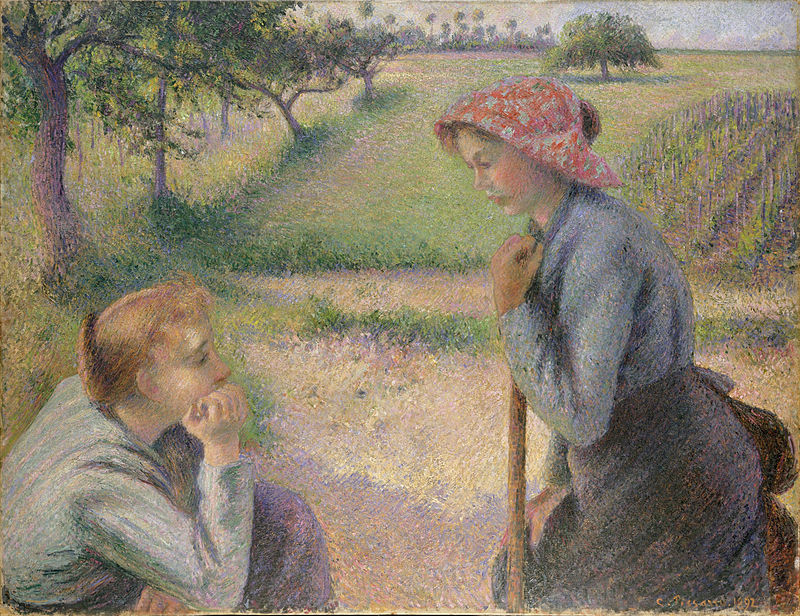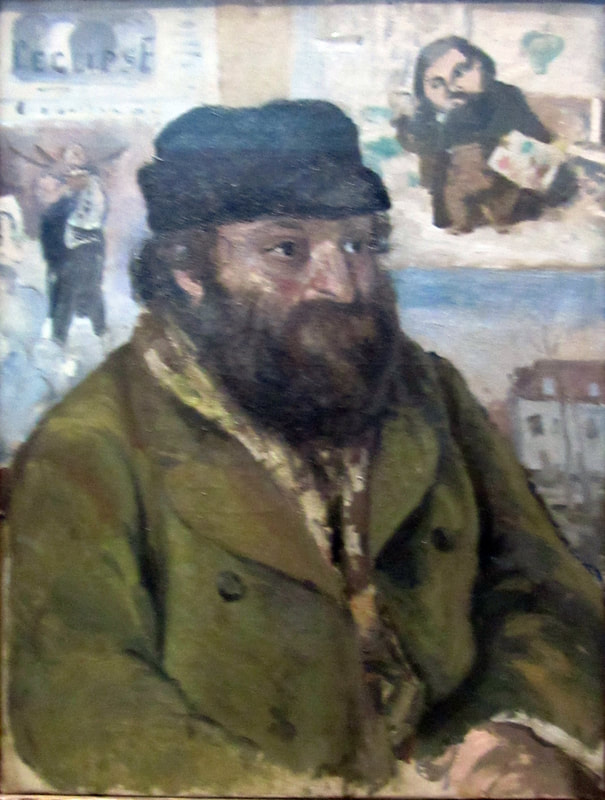AN APPRECIATION: Camille Pissaro
Camille Pissarro was one of the driving forces behind the Impressionist movement. Indeed, the other Impressionists referred to him as "Pere Pissaro" (Father Pissarro) because of his belief in the movement and the fatherly role he provided to his younger colleagues. While not as much of a household name as Monet or Renoir, Pissarro's work can be seen in major museums around the globe.
Career Pissarro was born in St. Thomas in the Virgin Island (see our article on Pissarro's birthplace). He was the son of a local merchant of French-Portuguese descent who had come to St. Thomas, then a Danish colony, in order to take over the business of his deceased uncle. He fell in love with his uncle's widow and married her. The local synagogue condemned this marriage and so the Pissarros were treated as outsiders, a role their son would embrace throughout his life. At the age of 12, Pissarro was sent to boarding school in France. Already interested in art, during this period, he had access to the great art housed in the museums of France. Returning to St. Thomas five years later, Pissarro was expected to work in the family business. For a time, he did so although he was uncomfortable with the bourgeois lifestyle and took every opportunity to work on art. Then, when he was 21, he encountered Fritz Melbye, a Danish artist, who was visiting St. Thomas. Melbye encouraged Pissarro's interest in art and together they fled to Venezuela to pursue art. Two years later, Pissarro returned again to St. Thomas. His family recognized that he would never become a businessman and permitted him to go to France to try and become a professional artist. In 1855, Pissarro moved to Paris where he became the assistant to painter Anton Melbye, his friend Fritz's brother. At the Universal Exhibition, Pissarro was impressed by the work of Camille Corot and the Barbizon School. In particular, Pissarro liked their style of open-air painting and their realistic depictions of peasants and country-life. Pissaro modeled his early style on Corot. In the beginning, Pissarro's approach to his profession was rather conventional. He studied at the academic Ecole des Beaux-Arts, copied paintings in the Louvre and submitted his works for exhibition at the annual Salon, the prestigious official art exhibition. However, as time went on he became increasingly dissatisfied with this approach. In addition, he became friends with a number of like-minded younger artists who he met at the Academie-Swiss, a free studio. In the cafes, Pissarro would preach to Claude Monet, Paul Cezanne, Pierre Auguste Renoir, Edgar Degas, Alfred Sisley and others about the flaws in the conventional system and would urge developing a new approach to art. The Franco-Prussian War of 1870 interrupted this movement and scattered its members. Pissarro, like Monet, fled to England. There, Pissarro settled outside London and painted scenes of the area surrounding London. When he returned to France, Pissaro found that the Prussian army had used his house as a butcher shop and in the process destroyed most of Pissarro's paintings. Therefore, Pissarro began building a new body of works in the style that he had developed in England. Influenced by the works of John Constable and J.M.W. Turner that he had seen in England, as well as by Monet's ideas about light, this style became his Impressionist style. Continuing to champion an alternative approach to exhibiting art, Pissaro and 14 other artists including Monet, Renoir, Degas, Sisley and Berthe Morisot, banded together to stage an exhibition of their works in a photographers studio in Paris. This exhibition became known as the First Impressionist Exhibition. Despite the critical attacks on his work and that of his colleagues, Pissaro remained committed to these group exhibitions. Indeed, he would be the only artist to participate in all eight of the Impressionist exhibitions over the next 12 years. By the late 1870s, several of the original group were no longer participating and primarily due to efforts by Degas, a number of other artists joined including Mary Cassatt and Gustave Caillebotte. Pissarro approved of these new additions as vital to his dream of creating an alternative approach to art. Meanwhile, Pissaro's style was changing. Working along with Cezanne and Paul Gauguin, Pissaro had had a strong influence on the younger artists' styles. However, they had also had a noticeable impact on Pissaro's style. Then, in 1884, Pissaro met two young painters, Georges Seurat and Paul Signac, who had developed a new style in which small dots of color placed next to each other on the canvas were blended by the viewer's eyes in order to form an image. Pissarro saw pointillism as revolutionary and adopted this style. With the enthusiasm of a convert, Pissarro preached Neo-Impressionism to his Impressionist friends and when they did not follow, condemned them as “romantics” rather than “scientific.” The others took this criticism in stride as Pissarro was well-liked and respected by the others. Still, by 1889, Pissarro was becoming disenchanted with this approach, finding that it limited his ability to express himself. During the 1890s, Pissarro developed a style that was an enhanced version of his style of the 1870s. Whereas he had long favored country scenes, he increasingly turned to urban subjects. This was in part due to a persistent eye infection that prevented him from painting outdoors. Instead, he would paint scenes looking out of hotel windows. Also, in order to capture the changing effects of light, he began to paint series depicting the same subject under various light conditions. For most of his career, financial difficulties haunted Pissarro. However, in the last decade of his life, his work became recognized and he achieved financial security. Pissarro died in 1903. Private life In 1871, Pissaro married Julie Vellay, while the couple were living in England. The daughter of a French vineyard grower, she had been his mother's maid. The couple had been together for a number of years before they were married and already had a son. However, they had delayed marrying because Pisaaro's mother objected to him marrying outside the Jewish faith. The Pissaros had eight children. Three of his sons became artists. Several members of subsequent generations became artists or art historians. Analysis Pissarro was vital to the Impressionist movement. Indeed, it was largely due to his personality that these artists came together. He acted as a counselor, providing moral support and encouragement to the others. For this, we owe him a lot given the achievements of the Impressionists. Still, it has been said that from an artistic standpoint Pissarro was not the group's “man of ideas.” Monet is most often cited as having performed that role. However, Degas, Renoir, Cezanne and Gauguin can all lay claim to the title “trailblazer”. Pissarro picked up on ideas first articulated by the others. However, he did not simply copy them. There are times when his work looks like a Monet, or looks like a Cezanne or a Gauguin but they always retain that Pissarro flavor. He brought something to each work. His sense of composition was always first rate, partiularly his use of perspective. Owing to the destruction of most of Pissarro's early works during the Franco-Prussian War, most of the Pissaros one encounters are from three periods: the 1870s Impressionist period; the Neo-Impressionist period; and the 1890s enhanced Impressionist period. Of these, the works of his first and third periods are the easiest to like. While there are some good paintings in the Neo-Impressionist period, as Pissaro himself eventually realized, the style was too constrained and artificial to convey real emotion. While his scenes of the countryside are often excellent, the urban scenes that he did looking out of hotel windows during his third period are the most memorable. They are unique and instantly recognizable as Pissarros. |
From Pissarro's Impressionist period: "Entree des village de Voissine" (above) and "Garden of Mathurin" (below).
Above: "Two Peasant Girls Chatting" a late Neo-Impressionist work.
Below: Pissarro's portrait of Cezanne recalls Cezanne's own style. For most of his career, Pissarro was inspired by scenes of the countryside. However, late in his career, he began to turn more often to urban scenes such as "Garden of the Tuilleries in Spring" (above), "Mardi Gras on the Boulevards" (below) and the almost abstract "Boulevard Montmarte at Night" (bottom)
See our profiles of these other Impressionists and members of their circle.
Frederic Bazille Eugene Boudin Marie Bracquemond Gustave Caillebotte Mary Cassatt Paul Cezanne Edgar Degas Henri Fantin-Latour Paul Gauguin Eva Gonzales Armand Guillaumin Edouard Manet Claude Monet (Part I The Early Years) Claude Monet (Part II High Impressionism) Claude Monet (Part III The Giverny Years) Berthe Morisot Pierre Auguste Renoir Alfred Sisley Suzanne Valadon Victor Vignon |
Artist appreciation -Camille Pissarro






